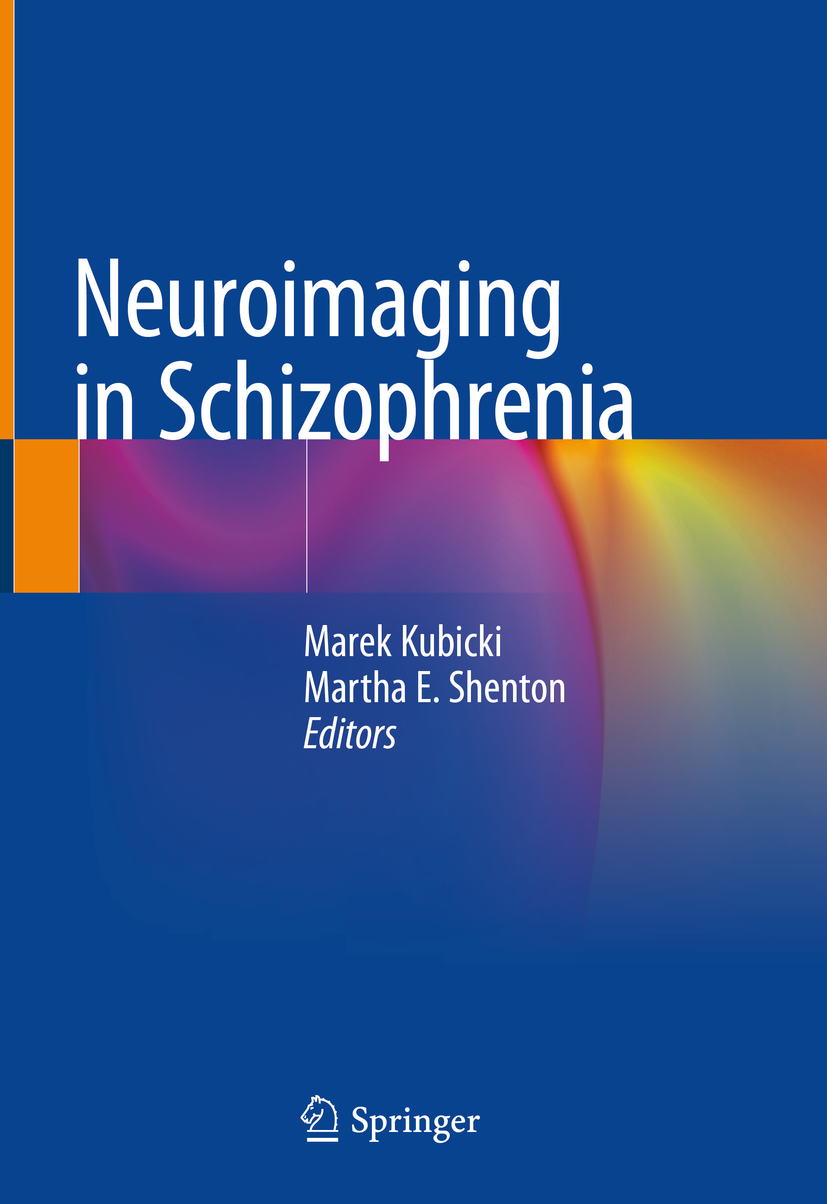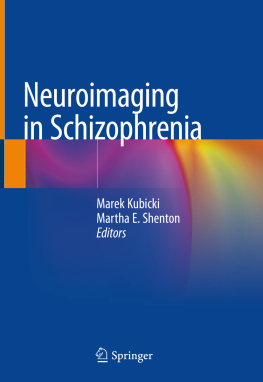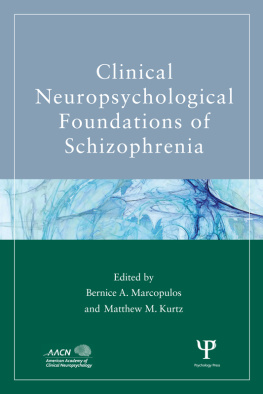Marek Kubicki - Neuroimaging in Schizophrenia
Here you can read online Marek Kubicki - Neuroimaging in Schizophrenia full text of the book (entire story) in english for free. Download pdf and epub, get meaning, cover and reviews about this ebook. year: 2020, publisher: Springer International Publishing, genre: Romance novel. Description of the work, (preface) as well as reviews are available. Best literature library LitArk.com created for fans of good reading and offers a wide selection of genres:
Romance novel
Science fiction
Adventure
Detective
Science
History
Home and family
Prose
Art
Politics
Computer
Non-fiction
Religion
Business
Children
Humor
Choose a favorite category and find really read worthwhile books. Enjoy immersion in the world of imagination, feel the emotions of the characters or learn something new for yourself, make an fascinating discovery.
- Book:Neuroimaging in Schizophrenia
- Author:
- Publisher:Springer International Publishing
- Genre:
- Year:2020
- Rating:4 / 5
- Favourites:Add to favourites
- Your mark:
- 80
- 1
- 2
- 3
- 4
- 5
Neuroimaging in Schizophrenia: summary, description and annotation
We offer to read an annotation, description, summary or preface (depends on what the author of the book "Neuroimaging in Schizophrenia" wrote himself). If you haven't found the necessary information about the book — write in the comments, we will try to find it.
Neuroimaging in Schizophrenia — read online for free the complete book (whole text) full work
Below is the text of the book, divided by pages. System saving the place of the last page read, allows you to conveniently read the book "Neuroimaging in Schizophrenia" online for free, without having to search again every time where you left off. Put a bookmark, and you can go to the page where you finished reading at any time.
Font size:
Interval:
Bookmark:


This Springer imprint is published by the registered company Springer Nature Switzerland AG
The registered company address is: Gewerbestrasse 11, 6330 Cham, Switzerland
Present-day imaging techniques are powerful diagnostic tools that are routinely employed in many areas of medicine. In most applications, imaging techniques play a more secondary role to the first line of medical care, such as clinical examination or laboratory tests, that guide clinical diagnosis. However, when the organ of interest is less accessible, imaging techniques play a more primary role. This is particularly true for the brain, arguably the most complex of human organs. Indeed, over the last three decades neuroimaging has been the only noninvasive technique to provide insight into the living brains structure and function. Moreover, these techniques, particularly in the context of neuroscience research applications, have provided an unparalleled ability to study the human brain in both health and disease.
Many of the most advanced neuroimaging techniques have been applied to the study of neuropsychiatric disorders. The application of imaging techniques to neuropsychiatric disorders has not been limited to addressing more traditional research questions (i.e., casecontrol comparisons in brain structure or function) many of which could not be addressed prior to the development of such toolsbut have also now expanded to encompass studies that are aimed at identifying imaging-based markers for diagnosis, prognosis, or treatment efficacy. Modern-day scanners have the capacity to visualize brain structures with close microscopic precision, in a manner heretofore not possible, allowing advances in the measurement of underlying biological mechanisms such as molecules that can penetrate bloodbrain barrier or individual cellular organelles. There is also a strong emphasis to establish big data repositories that would facilitate clinical and/or imaging queries, as well as an emphasis on machine-learning approaches that are capable of learning and improving data analysis iteratively, without supervision. These are just a few of the examples of advances in the field of neuroimaging over the last 30 years, which have changed the landscape of what is possible with respect to understanding the brain.
Neuroimaging techniques have been applied to schizophrenia more than any other psychiatric disorder. In the past, imaging approaches could not quantify the subtle alterations in the brains of individuals with schizophrenia because more sensitive tools were needed. With the advent of advanced imaging tools, we now know a great deal more about schizophrenia. However, the multitude of methods used, in addition to the large number of publications, have made the field quite complex to navigate for clinicians and scientists. Further, at this time, little effort has been made to map these research findings into a thoughtful and easily accessible library that can succinctly capture the state of the field of neuroimaging in schizophrenia, along with some of the promising inroads for understanding the neurobiology of this devastating disease. In the chapters that follow we highlight some of these efforts. This book is intended to provide an overview of neuroimaging findings in schizophrenia. The target audience includes clinicians, PhD students in psychology or neuroscience, medical students, residents in psychiatry, as well as experienced researchers, who, in the quest for understanding schizophrenia, want an overview in areas in which they have not specialized themselves, but want to understand the state of other imaging modalities.
This book is divided into two partsPart I provides detailed synopses of imaging techniques that have been employed in schizophrenia research, paired with the conclusions that have been drawn regarding how changes in brain structure and/or function may contribute to schizophrenia. In contrast, Part II provides representative examples of applications in which the use of neuroimaging techniques have made a significant impact. We end with a chapter that, while highlighting the existing shortcomings of the field, suggests possible solutions in the form of formulating future directions for the field of schizophrenia in general and neuroimaging in schizophrenia in particular.
The chapters are written by world-renowned experts in the field whom we asked to address the newest and most important developments in neuroimaging research in schizophrenia. We asked these experts to place these developments within the context of the last 30 years of research. Our purpose was to bring the reader closer to understanding the intricacies, advantages, and disadvantages of various imaging techniques, and to provide a greater understanding of how researchers in the field are using these techniques to test clinical hypotheses, or to develop clinically relevant biomarkers of disease onset, treatment response, or long-term prognosis. Our purpose was also to demonstrate, and to discuss, a path forward that merges imaging and non-imaging measures to build and to test hypotheses that may lead to a more comprehensive understanding of the neurophysiology, neurobiology, or neurotransmission pathologies involved in the clinical picture of schizophrenia. We hope that by showcasing many of the new challenges that the field of neuroimaging in schizophrenia now face, we could provide a roadmap for the future generation of researchers that will guide them toward finding solutions to many of todays questions.
We would like to acknowledge several people without whom this book would not have come to fruition. First of all, we are grateful to all the authors and co-authors of the chapters who agreed without hesitation to be part of this endeavor, and we are grateful also for delivering their thoughtful, comprehensive, and innovative contributions. We would like also to acknowledge our family members: our spouses Zuzanna and George, and our children: Michalina, Anthony, and Jessica for support and inspiration (often scientific). We would also like to thank Elizabeth Rizzoni for her help with editing and formatting. Finally, we acknowledge Harvard Medical School and the Department of Psychiatry at Brigham and Womens Hospital and Massachusetts General Hospital for supporting our work, the National Institute of Health, and the VA for funding our research, and Springer for giving us the opportunity to showcase the state-of-the-neuroimaging techniques in schizophrenia research.
Font size:
Interval:
Bookmark:
Similar books «Neuroimaging in Schizophrenia»
Look at similar books to Neuroimaging in Schizophrenia. We have selected literature similar in name and meaning in the hope of providing readers with more options to find new, interesting, not yet read works.
Discussion, reviews of the book Neuroimaging in Schizophrenia and just readers' own opinions. Leave your comments, write what you think about the work, its meaning or the main characters. Specify what exactly you liked and what you didn't like, and why you think so.












